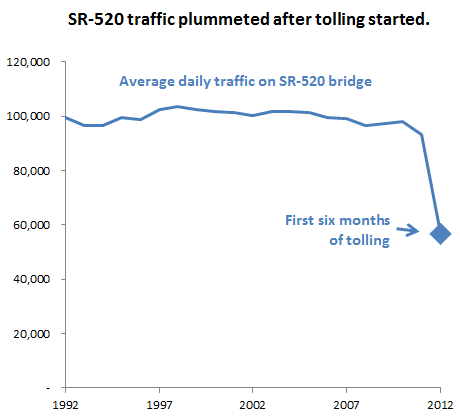Here’s a blast from the past: WSDOT’S early forecasts, dating from 2002, of traffic on the SR-520 floating bridge after the start of tolling. Depending on the tolling scenario, WSDOT predicted that the floating bridge would carry between 90,000 and 98,000 cars per day in the first year of tolling, down from a projected baseline of 118,000 cars per day with no tolling. (The report isn’t available online, but I’ve uploaded a scanned copy here.)
But the reality for January through June, the first six months of tolling: an average of 63,500 cars on weekdays, down from a baseline of 101,100 weekday cars the prior fall. When you include weekends as well, the trends are even more striking, with a dip to fewer than 57,000 cars per day.
WSDOT’s early forecasts were doubly mistaken: they overestimated the growth in the traffic baseline from 2002 to the time that tolling started, and they underestimated how many cars would avoid 520 after tolling began (even though they knew there were toll-free alternatives just down the road). It’s almost as if there’s a pattern here…as if, just maybe, the Puget Sound traffic models just don’t work all that well.
In fact, given the numbers to date, I think it would be fair to ask whether WSDOT really knew what it was doing when it decided that it absolutely needed to build a 6-lane bridge.


Comments are closed.